Warren J. Smith, Rockwell Collins Optronics
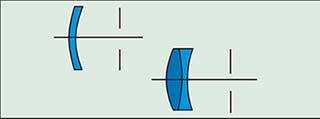 Simple Meniscus Lens
Simple Meniscus Lens
The simple meniscus lens is almost universally used in inexpensive cameras. To get an image of good quality it must be used with a separate aperture stop, reducing the aperture of the lens and the aberrations and their effects. The stop also selects the pencil of off-axis rays that passes through the lens; this controls astigmatism and eliminates coma. Spherical and chromatic aberrations and field curvature are totally uncorrected, but are rendered tolerable by the low speed —about f/10 to f/15. Distortion is uncorrected. The stop may be before or behind the lens, although it is always on the concave side. If the meniscus lens is compounded, chromatic aberration can be corrected and spherical reduced slightly, but this is not an economical solution. A diffractive surface (which is a Fresnel surface with a step height of λ/(n-1)) can be used to achromatize, athermalize or correct the aberrations of a single element lens. Such a surface can be molded on a plastic lens. Diffractive surfaces have been used in inexpensive cameras, eyepieces for headmounted displays and several other applications.
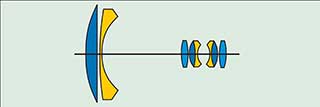 Retrofocus
Retrofocus
The retrofocus, or reversed telephoto lens, is usually composed of an ordinary objective with a negative component near its front focal point. Because of its relatively large back-focus and size, it is most useful for short-focal-length, wide-angle applications. In its early form the rear member was a standard objective, but modern versions tend to be designed as a unit and are difficult to classify. A new class of wide-angle lens has evolved from this form, as the bending of ray bundles outward by the negative member lends itself to this application. In a wide-angle configuration there is usually a fairly complex positive member closely enveloping the stop with symmetrically arranged meniscus negative elements on either side.
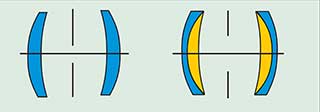 Double Meniscus System
Double Meniscus System
The arrangement of the two simple meniscus lenses on either side of the aperture stop is called a periscopic lens. Symmetrical about the stop, it has greatly reduced coma, lateral color and distortion. Spherical aberration is slightly better than in the single meniscus, but axial color and field curvature are slightly worse. If the two menisci are achromatized, the chromatic aberration is eliminated and the spherical is somewhat reduced. However, the remaining spherical aberration and the field curvature limit the lens to a speed of about f/8. Known as the rapid rectilinear, this was once a very popular lens for medium-priced cameras.
 Meniscus Anastigmat – Protar and Dagor
Meniscus Anastigmat – Protar and Dagor
The first true anastigmats used a thick meniscus construction to achieve the wide separation of convex and concave surfaces necessary to flatten the field. Correction of chromatic and spherical aberration was accomplished by the cemented surfaces. Although limited to speeds of f/8 to f/4.5 by heavy residual spherical aberration, these anastigmats are still useful as moderately wide-angle lenses, and are capable of excellent definition when stopped a bit below their full aperture.
 Dogmar/Aviar
Dogmar/Aviar
Historically known as the Celor, this lens was derived from the Dagor, although it can be regarded as a triplet with a split flint element. It is an excellent general-purpose photographic lens and can be designed with a wider-than-normal field. This design form is also used extensively in high-quality commercial process lenses and in enlarging lenses.
 Cooke Triplet
Cooke Triplet
The Cooke triplet anastigmat is the simplest lens in which all the primary aberrations can be corrected. Consisting of two positive crown elements on either side of and spaced away from a negative flint element, this lens gives the designer the necessary freedom (shapes, powers and spacings) to do a reasonably complete correction job. As a result, it is a popular and economical choice for a wide range of applications. At f/5.6, compact triplets can cover fields up to 60°. At the other extreme, high-index crown glasses make speeds above f/2 feasible for short-focal length, narrow-angle applications. The Cooke triplet is probably the most widely used photographic lens, either in its original form or in one of its many derivatives.
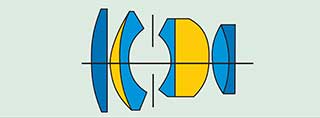 Double Gauss
Double Gauss
This is one of the most powerful design forms and is the basis of most high-speed (over f/2) camera lenses. Derived from the Gauss form of telescope objective, which consisted of a meniscus crown and a meniscus flint, both convex to the long conjugate, the double Gauss retains the excell spherochromatic correction of its ancestor. Perhaps the most serious defect in this design is oblique spherical aberration, which is usually kept in check by carefully vignetting the oblique pencils. Many modifications of this design exist; the outer crowns have been split and compounded, and the doublets have been air spaced or made into triplets.
 Tessar
Tessar
Although it is externally very similar to the Cooke triplet, the Tessar was actually derived from the Protar, a totally different form of lens. While its applications, coverages and speeds are similar to those of the triplet anastigmat, the Tessar is a significantly better lens, usually showing somewhat better coverage, definition or versatility. Many good enlarging lenses and medium-speed “normal’’ camera lenses are of the Tessar type.
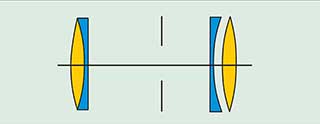 Petzval Portrait Lens
Petzval Portrait Lens
Because of its relatively high speed (f/3) and narrow field of good definition, the Petzval lens was originally used in 19th-century portrait photography. In its modern form, the order of the elements in the rear achromat is reversed and the elements are cemented together. Useful for motion picture projection, the lens has been increased in speed to about f/1.6, but angular coverage is limited by field curvature to about 10°.
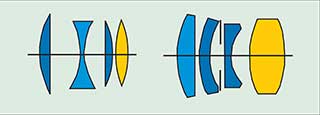 Split-Crown Triplet
Split-Crown Triplet
This descendant of the Cooke triplet was created by splitting one of the crown elements into two to reduce the aberrations. The improvement has primarily increased the speed of the lens. For example, with ordinary dense barium crown glass, the Cooke triplet is limited to speeds of about f/3.5. With a split-crown element the aperture is approximately doubled, although the field coverage is reduced.
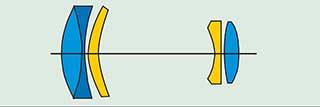 Telephoto
Telephoto
A telephoto lens has a focal length that is longer than the distance from the front vertex of the lens to the focal plane. This is accomplished by using a positive front member widely separated from a negative rear member. Distortion is difficult to control because of the basic lack of symmetry, but the arrangement does tend to flatten the field. However, extreme telephoto ratios can cause an overcorrection of the field curvature because of the strong negative member required.
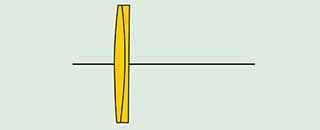 Fraunhofer Telescope Objective
Fraunhofer Telescope Objective
This is the classic form for a refracting telescope objective. Covering only a narrow field, it can be corrected for three aberrations: spherical, coma and chromatic.
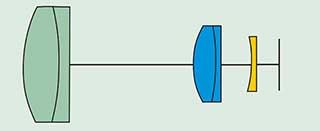 Petzval Projection Lens with Field Flattener
Petzval Projection Lens with Field Flattener
The Piazzi-Smyth field flattener is a strong negative element placed close to the focal plane to counteract the inherent inward-curving field of the Petzval lens.
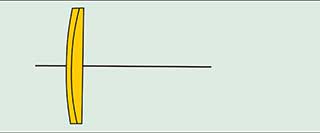 Petzval Projection Lens
Petzval Projection Lens
Although similar in performance to the Fraunhofer objective, the low durability of the flint-in-front element makes it less attractive for most applications.
 Gauss Telescope Objective
Gauss Telescope Objective
Consisting of two meniscus-shaped elements, the Gauss lens has somewhat better correction for spherochromatism than the Fraunhofer or the Steinheil, but its residual spherical aberration and coma are so much worse that the Gauss is rarely used.
 Infrared Telescope Objective
Infrared Telescope Objective
The high refractive index and extreme (both high and low) dispersions of infrared materials produce unusually shaped elements.
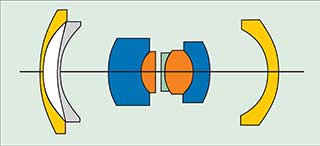 Angulon/Biogon
Angulon/Biogon
This family of wide-angle lenses has outer negative meniscus elements both front and rear. These effectively reduce the field angle for the inner members.
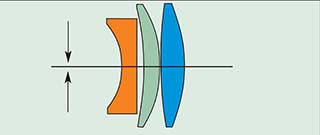 Laser Scanner Lens
Laser Scanner Lens
The external pupil is located at the scanning mirror; monochromatic light allows the use of high-index flint for positive elements and low-index crown for negative elements. An f-Theta distortion characterizes these lenses.
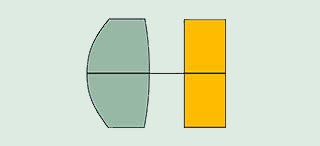 Laser Disk Lens
Laser Disk Lens
Monochromatic light and a very narrow field of view allow a single thick element with one or two aspheric surfaces to deliver diffraction-limited performance. They are usually molded from glass or plastic.
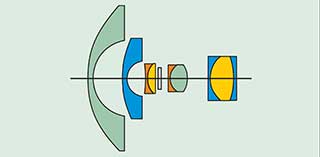 Fish-Eye Lens
Fish-Eye Lens
A fish-eye lens covers a field of 180° or more by using strong negative meniscus front elements. The result is a long working distance and a lot of barrel distortion.
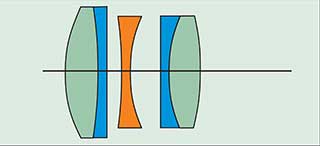 Heliar
Heliar
The Heliar provides an improvement over the classic Tessar form because of its approximate left-to-right symmetry. It is often used for camera and enlarger lenses.
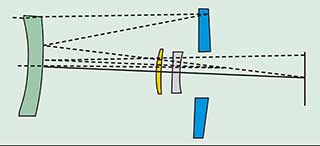 Catadioptric
Catadioptric
A catadioptric system combines mirrors and refracting surfaces, which are used to correct the aberrations of the mirrors.
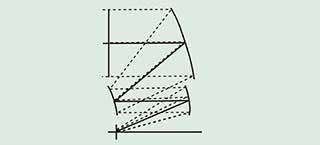 Unobscured Aperture Mirror System
Unobscured Aperture Mirror System
These arrangements avoid the severe loss of image contrast that results from the central obscuration by the secondary mirror in the Cassegrain, Gregorian and Schwarzschild systems.
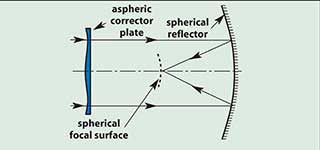 Schmidt System
Schmidt System
Combines an aspheric corrector plate with a simple spherical mirror to provide a wide field and large aperture.
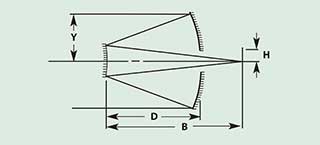 Cassegrain Telescope
Cassegrain Telescope
This is the basic mirror system for most astronomical telescopes and many infrared systems. Both mirrors are usually aspheric. It yields a long focal length in a compact package. The mirror equivalent of a telephoto lens.
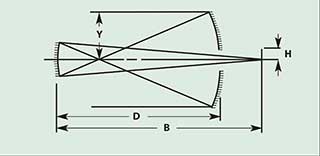 Gregorian Telescope
Gregorian Telescope
A rarely used form, it does have an internal image plane.
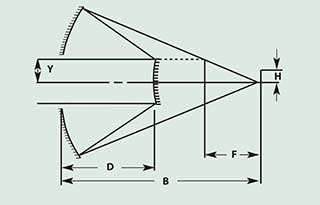 Schwarzschild System
Schwarzschild System
This is often used for UV and IR microscope objectives, where the short focal length makes the (relatively) large concave mirror’s size acceptable. The mirror is the equivalent of the reverse telephoto or retrofocus lens.
References
Smith, Warren J. (2004). Modern Lens Design, 2nd Edition. McGraw-Hill, Inc., New York.
Kingslake, Rudolf (1989). A History of the Photographic Lens. Academic Press.
Smith, Warren J. (2000). Modern Optical Engineering. 3rd Edition. McGraw-Hill, Inc., New York.